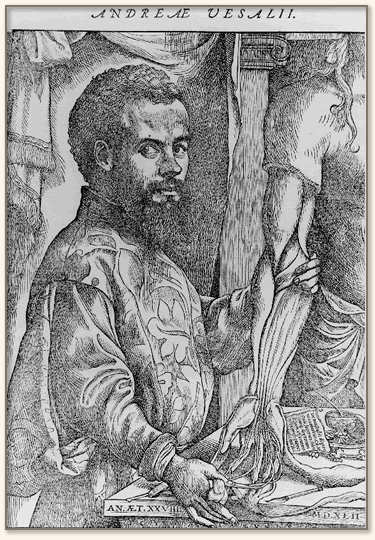Andreas Vesalius is credited with the establishment of modern human anatomy. He was born in Brussels, Belgium in the Holy Roman Empire and spent most of his career in Padua, Italy (at the University of Padua), the center of the most rapid and meaningful medical advances of the time. Here, Vesalius was able to academically study anatomy; he was even given access to human bodies for dissections, which was a privilege that was unlikely to have been granted anywhere else in the world. None of his historical predecessors were allowed to work with humans, perhaps explaining why Vesalius was the first to describe anatomy with a degree of accuracy acceptable even today.
Drawings, engraved in woodcuts, were the most important means of documenting his findings. It is likely that Vesalius worked with a draftsman to produce these drawings, but I chose to write about Vesalius because it is unclear who he worked with and because he is known to have planned all of them. Vesalius published De Humans Corporis Fabrica (The Fabric of the Human Body) in 1543.
 |
| Portrait of Vesalius from De Humans Corporis Fabrica (DHCF) drawn by someone else. |
Drawings, engraved in woodcuts, were the most important means of documenting his findings. It is likely that Vesalius worked with a draftsman to produce these drawings, but I chose to write about Vesalius because it is unclear who he worked with and because he is known to have planned all of them. Vesalius published De Humans Corporis Fabrica (The Fabric of the Human Body) in 1543.
 |
| Drawing of male musculature from DHCF. |
The drawings in his book were influenced by Renaissance practices, particularly the way that shading was used to make literal and accurate representations and the fact that they were printed using woodcuts. For this reason, his book is of great value not just to the medical community but also to the artistic one.
 |
| Drawing of skeleton from DHCF. |
 |
| A body suspended against a post from DHCF. |
 |
| A series of positioned cadavers showing human musculature from DHCF. |
These drawings tend to depict skeletons or cadavers in natural and lifelike positions rather than simply "on the table." Vesalius believed that the human body is art, which might have influenced the decision to use these positions. Additionally, the variety of positions enabled the users to see how the muscles could change, meaning that readers could see the movement of muscles through static drawings.
I chose Vesalius (again, even though it was likely an unknown draftsman who did most of the final drawings) because he combined art and the sciences with critical proficiency in both. I have a special appreciation for the drawings of De Humans Corporis Fabrica because they accurately capture the anatomical structures in a way that has helped advance medical care for centuries while being beautiful from an artistic standpoint. It's not just the realistic shading and lines that appeal to me but also the creative and lifelike positioning of the cadavers. Though the varying positions of the bodies has medical relevance because they capture the dynamic aspects of anatomy, the scenery and surrounding details put in the drawing seem to serve an entirely artistic purpose. I think that drawing people is one of the most challenging skills that I hope to have one day, and seeing a person build from within (anatomically) has given me a new perspective.
References
Raphaël Cuir. The development of the study of anatomy from the Renaissance to Cartesianism : da Carpi, Vesalius, Estienne, Bidloo. Lewiston, N.Y.: Edwin Mellen Press, (c)2009.
"Andreas Vesalius (1514-1564)." BBC History. http://www.bbc.co.uk/history/historic_figures/vesalius_andreas.shtml
"Andreas Vesalius." Anatomy in the Age of Enlightenment. University of Michigan. http://www.umich.edu/~ece/student_projects/anatomy/people_pages/vesalius.html
"Comparative Anatomy: Andreas Vesalius." Understanding Evolution. http://evolution.berkeley.edu/evolibrary/article/history_02
No comments:
Post a Comment